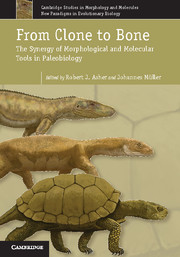Book contents
- Frontmatter
- Contents
- Contributors
- 1 Molecular tools in palaeobiology: divergence and mechanisms
- PART I Divergence
- 2 Genomics and the lost world: palaeontological insights into genome evolution
- 3 Rocking clocks and clocking rocks: a critical look at divergence time estimation in mammals
- 4 Morphological largess: can morphology offer more and be modelled as a stochastic evolutionary process?
- 5 Species selection in the molecular age
- PART II Mechanisms
- 6 Reconstructing the molecular underpinnings of morphological diversification: a case study of the Triassic fish Saurichthys
- 7 A molecular guide to regulation of morphological pattern in the vertebrate dentition and the evolution of dental development
- 8 Molecular biology of the mammalian dentary: insights into how complex skeletal elements can be shaped during development and evolution
- 9 Flexibility and constraint: patterning the axial skeleton in mammals
- 10 Molecular determinants of marsupial limb integration and constraint
- 11 A developmental basis for innovative evolution of the turtle shell
- 12 A molecular–morphological study of a peculiar limb morphology: the development and evolution of the mole's ‘thumb’
- 13 Manus horribilis: the chicken wing skeleton
- Index
- Plate-section
- References
8 - Molecular biology of the mammalian dentary: insights into how complex skeletal elements can be shaped during development and evolution
Published online by Cambridge University Press: 05 November 2012
- Frontmatter
- Contents
- Contributors
- 1 Molecular tools in palaeobiology: divergence and mechanisms
- PART I Divergence
- 2 Genomics and the lost world: palaeontological insights into genome evolution
- 3 Rocking clocks and clocking rocks: a critical look at divergence time estimation in mammals
- 4 Morphological largess: can morphology offer more and be modelled as a stochastic evolutionary process?
- 5 Species selection in the molecular age
- PART II Mechanisms
- 6 Reconstructing the molecular underpinnings of morphological diversification: a case study of the Triassic fish Saurichthys
- 7 A molecular guide to regulation of morphological pattern in the vertebrate dentition and the evolution of dental development
- 8 Molecular biology of the mammalian dentary: insights into how complex skeletal elements can be shaped during development and evolution
- 9 Flexibility and constraint: patterning the axial skeleton in mammals
- 10 Molecular determinants of marsupial limb integration and constraint
- 11 A developmental basis for innovative evolution of the turtle shell
- 12 A molecular–morphological study of a peculiar limb morphology: the development and evolution of the mole's ‘thumb’
- 13 Manus horribilis: the chicken wing skeleton
- Index
- Plate-section
- References
Summary
Introduction
The mammalian dentary
One of the defining features of mammals is the manner in which the lower and upper jaws articulate. In most vertebrates with jaws (gnathostomes), the jaw joint is formed by the articulation of the quadrate bone in the cranial base and the articular, the proximal element of the compound tetrapod mandible. These elements are both derived from the proximal part of Meckel's cartilage, and are initially part of a single cartilaginous condensation, which later subdivides, hypertrophies and ossifies (Wilson and Tucker 2004). In the mammals, the jaw joint is formed by the articulation of two previously unopposed elements, the squamosal bone in the cranial base and the dentary bone, which in mammals forms the entire mandible. In humans this joint is known as the temporomandibular joint or TMJ. The squamosal and dentary are derived directly from the mesenchyme of the first pharyngeal arch via membranous ossification, and therefore have no cartilage template.
The German embryologist and anatomist Karl Reichert suggested in 1837 that the mammalian homologues of the tetrapod jaw articulation are to be found in the ossicles of the mammalian middle ear (1837, as reviewed in English by de Beer 1937), with the homologue of the articular bone being the malleus, while the quadrate's homologue is the incus. Other homologous components include the tympanic ring, which is a homologue of the angular, and gonial, the homologue of the pre-articular. This anatomical homology has recently been supported by genetic evidence, from studies in mice, chick and zebrafish (Miller et al. 2003; Tucker et al. 2004; Wilson and Tucker 2004). A transformation series, moving from a quadro-articular articulation to a squamosal-dentary articulation, can be observed in the fossil record, as the post-dentary bones reduce in size and the dentary enlarges (Luo 2007). Several premammalian cynodonts and mammaliaforms of the Late Triassic and Early Jurassic, such as Morganucodon, were in possession of both quadro-articulate and squamosal-dentary joints, where the quadro-articular had become somewhat more specialized in hearing, but has not completely lost its function as a jaw articulation (Kermack et al. 1981; Luo 2007).
- Type
- Chapter
- Information
- From Clone to BoneThe Synergy of Morphological and Molecular Tools in Palaeobiology, pp. 207 - 229Publisher: Cambridge University PressPrint publication year: 2012
References
- 5
- Cited by



